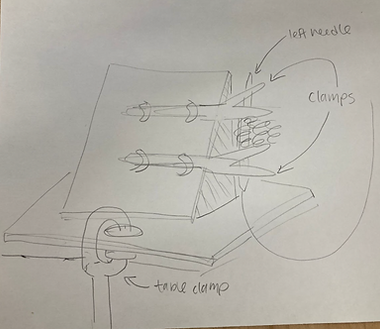
I designed and built a solution for one-handed knitting with circular needles for the 2022 Tufts Assistive Tech Hackathon with Juliette Kilgore, Maitreyi Kale, Anne Hu, and Malia Brandt.
We had one week to ideate and build a prototype for a knitting solution for a user who only has use of their right arm. Our group won the hackathon with this design!
Skills
User-centered design, cross-functional teamwork, brainstorming, fast prototyping
Assistive Tech
User Needs and Project Considerations
Our user is an avid knitter and loves to create complex, large items. They suffered a stroke and lost the use of their left arm, and is still determined to knit! Our user wanted a way to knit with circular needles (needles that are connected with a wire) so they could create larger items and other shapes like gloves or clothing. Here are some needs we identified before designing:
-
Can handle large and/or tube-shaped items
-
Easy to set up and transport with one hand
-
Easy to operate with one hand
-
Adjustable for a variety of environments
-
Safe and secure to use, won't damage knitting needles

Ideation
Over two brainstorming sessions, we settled on a design similar to the right-most image. We decided to use two pairs of vise-grip locking pliers to hold a stationary needle which allows our user to maneuver the other needle with one hand to complete stitches. I had the idea for the vise-grip pliers and I had a feeling they would work well due to how easy it is to open and close them. Working in a group was invaluable to creating robust ideas and I worked hard to incorporate input from each group member
We also sought out feedback from our user and adapted the design based on the outcomes of that conversation. Our user wanted the stationary needle to be a specific height so that knitted yarn could accumulate under it, while not being so high that it would make knitting uncomfortable.



Prototyping and Fabrication



Working together in between classes and during the weekend, we made a model out of cardboard, then created a prototype out of laser-cut wood and an assortment of other fast prototyping materials.
Testing and Iterations
After testing and conversations with our user, we added a pillow to the underside of the base so the device can be used on a lap. We also prototyped a belt and hook solution to increase tension in the yarn which makes one-handed yarn wrapping easier. Looking forward, a sturdier frame will help with overall stability and creating a more robust solution to supporting the free needle will improve the overall knitting experience.

